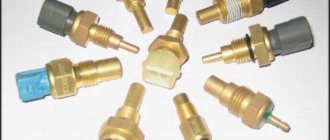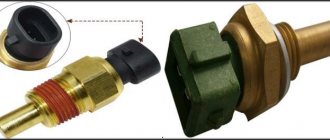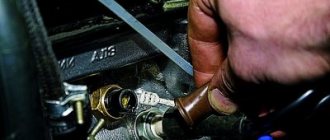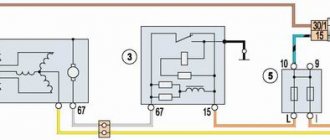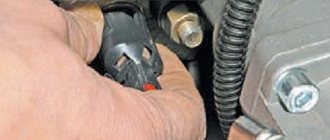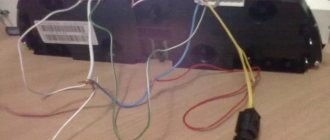We remove the sensor for replacement if irregularities are detected in the readings of the coolant temperature indicator in the instrument cluster. On a car with an F16D3 engine...
...the coolant temperature indicator sensor is screwed into the cylinder head in its lower part under the intake pipe of the first cylinder, next to the coolant temperature sensor of the control system (the intake pipe has been removed for clarity).
To remove it, drain the liquid from the cooling system.
Disconnect the wire from the temperature gauge sensor.
Using a 13mm head, unscrew the temperature gauge sensor...
...and remove it.
On a car with an A15SMS engine.
...the coolant temperature gauge sensor is located at the top of the engine - screwed into the threaded hole in the intake manifold.
Therefore, when replacing it, you can do without completely draining the coolant.
Drain a small amount of coolant through the radiator cap.
By sliding, disconnect the wire tip from the sensor.
Using a high head “12” we turn out the sensor...
...and remove it .
Install the sensor in reverse order. The thread of the sensor is conical, so we screw the sensor until the rotation resistance increases significantly, after which we slightly “tighten” the sensor. We pour coolant into the cooling system and bring its level to normal (see “Replacing the coolant”). ( 8
Source: https://daewoo.biz/remont-daewoo/nexia-2008/remont-avtomobilya/sistema-okhlazhdeniya/snyatie-datchika-ukazatelya-temperatury-okhlazhday/
Temperature sensor Daewoo Nexia
The equipment of the Daewoo Nexia car of the first and second generations is significantly different.
The changes affected not only the interior, but also the exterior, technical characteristics, and equipment. Among other things, the presence and placement of sensors for monitoring equipment operation. In particular, the air temperature sensor (hereinafter referred to as the ATS) was moved from the air line and installed between the first and second cylinders on the block.
The external temperature sensor (hereinafter referred to as DVT) is not preinstalled at all in the first generation Daewoo Nexia. The owner can install the device on his own.
What temperature sensors are installed
- Coolant temperature (CLT);
- Air temperatures (DTV);
- External temperature (ADT) – optional in the first generation. In the second generation as a staff unit.
DTOZH is designed to monitor the temperature of antifreeze in the cooling system circuit of the power unit. After receiving data about the “degree” of the engine, the ECU increases (lowers) the speed of the power unit in order to adjust the temperature.
The quality composition of the fuel mixture depends on the accuracy of the DTOZ readings. The service life of the sensor is unlimited, with the exception of mechanical damage or manufacturing defects.
The standard installation location is the surface of the thermostat. The base part of the DTOZH is screwed into the thermostat housing. Two power supply cables extend from the top.
A melting element is installed inside the DTOZh base. As soon as the antifreeze temperature reaches 90, the contacts close and the on-board computer signals an error.
Catalog articles, prices of temperature sensors for Daewoo Nexia:
| Name | Catalog item | Price in rubles |
| DTOZH (original) | PO4442352 (8 valves) | from 250 |
| DTV (factory version) | PO4179532 | from 250 |
| DVT (factory version) | PO4790564 (16 valves) | from 250 |
In the first generation it is mounted in the air duct, and in the second - between the first and second cylinders.
The main purpose is to control the “degree” of air flow at the engine inlet. In real time, the DTV transmits data to the electronic control unit of the ECU. The latter adjusts the crankshaft speed, engine speed, and mixture enrichment.
In the basic configuration, DVT is presented in the second generation of Daewoo. In the first, the owner can install it as additional equipment.
Location: under the front bumper, to the left of the radiator grille. For the purpose of prevention and replacement, there is no need to remove the front bumper at all; it is enough to remove the mud flaps at the bottom.
DTV
In the first generation it is mounted in the air duct, and in the second - between the first and second cylinders.
The main purpose is to control the “degree” of air flow at the engine inlet. In real time, the DTV transmits data to the electronic control unit of the ECU. The latter adjusts the crankshaft speed, engine speed, and mixture enrichment.
How to independently replace temperature sensors on a Daewoo Nexia car
- Open-end wrench set to “19”;
- Rags;
- Additional lighting is optional;
- New measuring device.
- Place the machine on a level platform;
- We turn off the engine, open the hood;
- We block the rear row of wheels with wheel chocks;
- Remove the power terminals from the battery;
- We snap off the limit switches on the DTOZH;
- We unscrew the sensor and replace it with a new one;
- We put on the limit switches, start the engine, check the functionality.
Do-it-yourself equipment replacement is complete.
The replacement process is completely simple:
- Open the hood;
- Using a flat-tip screwdriver, unclip the protective metal retainer on the sensor body;
- We remove the block with wires;
- We shoot DTV;
- We install a new one in its regular place;
- We assemble the structure in reverse order.
Finally, start the engine and check the readings on the dashboard.
Installed to the left of the center of the radiator grille under the front bumper. To carry out prevention, it is necessary to temporarily dismantle the mud shields.
Next we proceed to the replacement:
- Disconnect the block with wires;
- Unclip the protective lock;
- Install a new sensor;
- We put on the terminals;
- We assemble the structure in reverse order.
Signs of DTOZH malfunction
- The Check Engine sign is activated on the control panel. Most ECUs do not indicate a specific failure. To understand its essence, you need to install an OBD2 adapter.
- The vehicle's fuel consumption increases. Due to sensor failure, incorrect fuel regulator information will be visible on the instrument panel.
- Random operation of the cooling fan system. It consists of spontaneous switching on and off or complete failure of the mechanism.
- Instability of the engine when driving at low speeds. It may stall due to a violation of the cooling functions.
- Spontaneous engine stop when driving in hot engine mode. This occurs as a result of the fact that the antifreeze exceeded the critical heating level and evaporated, and the DTOZH was unable to start the ventilation system.
Recommendations for care and maintenance of sensors
- Strictly follow the manufacturer's recommendations regarding vehicle maintenance schedules;
- Buy parts with original catalog numbers. The exact data is indicated in the instruction manual for your technical device;
- Carry out preventive maintenance, install consumables and spare parts in certified service stations. Relevant while the car is under factory warranty. There are frequent cases of warranty cancellation due to third-party intervention.
- When the first signs of engine malfunction appear, contact a service station;
- Do not install sensors from other car brands, even though they are compatible. External similarity does not guarantee full functionality in action;
- Carefully check the catalog numbers on the parts when purchasing and compare them with the markings indicated in the operating instructions.
If you encounter any difficulties with replacement, please contact service station specialists or car dealership managers for help. Additionally, read reviews from car enthusiasts on the Internet.
Source
Some solutions to the condensation problem
Before replacing a faulty sensor with a known working one, it is worth drying it well to remove condensate. The pipe going to the sensor also needs to get rid of moisture. It is possible that after these procedures the unit will continue to perform its normal operation correctly.
Silicone
Car owners call silicone one of the ways to combat the problem of condensation. It completely fills the body of the device, which prevents subsequent moisture from entering its parts.
The procedure for modifying the DBP itself is quite simple: the case is opened at the place of gluing. The insides are filled with silicone construction sealant. The closing lid is installed in place, and the entire structure is dried on a radiator or in a warm place for 24 hours.
Filter
Another method to avoid moisture getting inside the detector is to place a gasoline filter on the pressure pipe between it and the DBP itself. Water will collect inside and stop entering the sensor.
Change location
One of the most radical ways is to change the location of the pressure-determining unit. It is moved to a place where the device is “warm” during operation, regardless of the ambient temperature. To do this, other fasteners are often made and the pipe is extended.
Engine with sensor attached outside of standard location:
Temperature sensor for Daewoo Nexia
Cars contain a large number of different sensors that allow the car owner to obtain information about the condition of the vehicle. At the same time, regardless of what type of engine is installed in the car - 8 cl or 16 cl, manufacturers equip the car with a temperature sensor. The performance of the motor depends on it. If it shows incorrect values, then it is impossible to determine engine heating. Next, we consider where the temperature sensor is located on the Daewoo Nexia, what malfunctions may occur and how the spare part is replaced.
The engine temperature arrow jumps: why does this happen and what should the driver do?
Many drivers are well aware that constant monitoring of engine temperature allows timely detection of possible problems with the cooling system and protects the engine from overheating and costly repairs.
For this reason, experienced car owners constantly pay attention to the internal combustion engine temperature gauge while driving a car.
In this article we will talk about why the engine temperature arrow rises, then the pointer drops, and also why the power plant temperature sensor may give incorrect readings, the engine temperature arrow floats while driving, etc.
Location
The Daewoo Nexia vehicle has several types of engines, and therefore the sensors are installed in different places:
- N150. DTOZH is located near the ignition module.
- N100. You can find the DTOZH under the distributor.
- F16D3. The gauges are located between cylinders 2 and 3.
Cooling system diagram
Let's look at what the Daewoo Nexia cooling system diagram looks like:
Elements of the DAEWOO NEXIA engine cooling system: 1-electric fan; 2-electric fan casing; 3.36-nuts; 4,7,9,10,12,13,15,17,18,20,27,29,32, 34,38 40,41,43,45,47-clamps;5,30,48,49,53 -bolts; 6-supply hose for heating the throttle assembly; 8-tee; 11-heater supply hose; 14-way hose; 16-outlet heater hose (the dotted line shows the shape of the hose when installing an automatic transmission); 19-outlet hose for heating the throttle assembly; 21-sensor for turning on the electric fan; 22-o-ring sensor; 23-thermostat housing; 24-o-ring thermostat cover; 25-thermostat; 26-water pump pipe; 28-outlet water pump hose; 31-connecting pipe; 33-fluid reservoir hose; 35 expansion tank; 37-expansion tank plug; 39-steam removal hose of the expansion tank; 42-radiator inlet hose; 44-radiator; 46-radiator outlet hose; 50-radiator mounting bracket; 51-upper radiator mounting pad; 52-electric air conditioning fan; 54-lower radiator mounting pad.
How to check functionality
The coolant temperature sensor can be checked as follows:
- If the readings are too high or low, you need to try to warm up the engine.
- In a situation where the measuring device shows too high readings when the engine is not warmed up, you need to disconnect all contacts from the DTOZH.
- If the device does not show any values at all, then you need to check the fuses, then turn off the car, disconnect the contact and ground it to the engine body. Turn on the ignition, but do not start the engine. If differences are observed, it is necessary to replace it.
Tools:
If there is a malfunction, the car has difficulty starting and sometimes stalls when idling. This sensor is located in the air filter housing on old Daewoo Nexia.
On new Nexias with the F16D3 engine it is located in the air supply pipe. If the answer is yes, then great! Since the culprit for a malfunction of the engine temperature gauge, in most cases, is the sensor responsible for collecting information about the coolant temperature. And if this same sensor stops working or starts showing random things, then there is only one way out - replacing it.
Where is the engine temperature gauge sensor located on Daewoo Lanos, Nexia and Chevrolet Lanos cars with a displacement 1 engine.
Catalog number of the temperature sensor for the coolant arrow of Daewoo Lanos, Nexia and Chevrolet Lanos cars with an engine capacity of 1. Sensor, which manufacturer can be recommended for purchase? I think if I answer that you should only take the original GM sensor, then I won’t surprise anyone.
Parts and consumables:
But this is the most correct choice. If it is not possible to buy a GM sensor, then I recommend choosing from manufacturers such as: These not only work, but also show data that is close to the truth. The sensor is connected to ground through its variable resistor.
Depending on the sensor signal, the ECU calculates the amount of air entering the engine. To check and replace the absolute pressure sensor you will need a voltmeter. Check the MAP sensor power supply circuit. Disconnect the wiring harness block from the sensor with the ignition off, connect the tester in the VOL mode and “C” terminal designations are marked on the sensor body, turn on the ignition and measure the voltage.
Turn off the ignition and connect the wiring harness connector to the sensor. If the voltage deviates from the norm, replace the absolute pressure sensor. Disconnect the vacuum hose and remove the sensor assembly with bracket. Remove the sensor from the bracket.
To check and replace the absolute pressure sensor you will need: Check the sensor's power supply circuit. To do this, press the latch.
Disconnect the wiring harness connector from the sensor connector with the ignition off. Connect the tester in the VOL mode and “C” pads, turn on the ignition and measure the voltage.
Daewoo Nexia 16v — Replacement of DTOZH (on the arrow)
Turn off the ignition, remove its cover from the block by releasing the latches, and connect the block to the sensor. Connect the tester in voltmeter mode to the harness wire connected to terminal “B” and to ground, start the engine, measure the sensor voltage. When the engine is idling, the voltage should be 1.0 - 1.5 V. To do this, disconnect the vacuum hose from the sensor fitting, unscrew the mounting bolt and remove the sensor. Install the absolute pressure sensor in the reverse order of removal.
It outputs a pulse signal to the computer, proportional to the speed of rotation of the drive wheels. No tool is required to replace the speed sensor.
Unscrew the tip nut of the flexible shaft of the speedometer drive from the speed sensor and disconnect the shaft. Disconnect the speed sensor wiring harness connector. Unscrew the speed sensor from the speedometer drive.
Install the speed sensor and all removed parts in the reverse order of removal.
To adjust the calculations of the duration of injection pulses, information about the presence of oxygen in the exhaust gases is used; this information is provided by the control oxygen concentration sensor. The oxygen contained in the exhaust gas reacts with the sensor, creating a potential difference at the sensor output.
It varies from approximately 0.1 V high oxygen - lean mixture to 1 V low oxygen - rich mixture.
By monitoring the output voltage of the oxygen concentration sensor, the controller determines which command to adjust the composition of the working mixture to send to the injectors. If the mixture is lean, then the controller gives a command to enrich the mixture, if the mixture is rich, to lean the mixture.
The diagnostic oxygen concentration sensor is installed behind the converter and operates on the same principle as the control sensor. The signal generated by the diagnostic oxygen concentration sensor indicates the presence of oxygen in the exhaust gases after the converter.
How is the replacement performed?
Replacing a component on a 16-valve engine (F16D3):
- It is necessary to disconnect the negative contact from the battery terminal.
- Then you need to drain the fluid in the system.
- Next, you need to carefully release the retaining clip and disconnect the conductors from the meter.
- Use a wrench to loosen the sensor.
- Finally, all that remains is to unscrew the DTOZH from the hole in the cylinder.
- You will need to treat the place where the DTOZH is attached with cleaning fluid and a rag.
- Next, install the new device and connect the contacts to it.
- Fill the radiator with coolant.
Replacement on N100/N150 engine:
- The engine should cool down.
- Disconnect all electrical wires from the sensor.
- Then you need to unscrew the three nuts and remove the ignition module.
- To relieve pressure, you need to remove the cap on the expansion tank.
- Drain the coolant from the radiator.
- Using the key, unscrew the DTOZH.
- Install a new meter.
- Fill with antifreeze and start the engine.
The performance of the engine depends on the temperature sensor. If the DTOZH cannot adequately display the readings, then there will be problems with starting the engine after overnight parking and in winter. It can also overheat and fail.
The temperature needle jumps when the thermostat and DTOZh are working
In some cases, it happens that the thermostat, as well as the temperature sensor and wiring, turn out to be working. In this case, the temperature arrow jumps arbitrarily, overestimating or underestimating the readings, in an arbitrary range.
Often the problem lies in the electronic board of the instrument panel. If the soldering of such a board turns out to be of poor quality, problems arise after a few years. The malfunction can be eliminated by disassembling the shield and re-soldering
As part of such work, special attention should be paid to resistors and output mass. If you plan to do the work yourself, you need to have a low-power soldering iron with a thin rod
As a result, the sensor reacts to changes in temperature, the pointer arrow changes position chaotically. At the same time, the air in the system is indirectly indicated by the fact that liquid is leaking from under the cap of the expansion tank, there may be a noticeable decrease in the level in the tank, etc.
